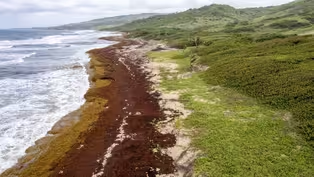
The career of Chien-Shiung Wu, the ‘First Lady of Physics’
Clip: 3/19/2023 | 2m 48sVideo has Closed Captions
The career of Chien-Shiung Wu, the ‘First Lady of Physics’
This Women’s History Month, we’re highlighting stories of women whose contributions have often been overlooked. Tonight, we look at the career of Chien-Shiung Wu, a 20th-century physicist who made indelible changes to her field.
Problems playing video? | Closed Captioning Feedback
Problems playing video? | Closed Captioning Feedback
Major corporate funding for the PBS News Hour is provided by BDO, BNSF, Consumer Cellular, American Cruise Lines, and Raymond James. Funding for the PBS NewsHour Weekend is provided by...

The career of Chien-Shiung Wu, the ‘First Lady of Physics’
Clip: 3/19/2023 | 2m 48sVideo has Closed Captions
This Women’s History Month, we’re highlighting stories of women whose contributions have often been overlooked. Tonight, we look at the career of Chien-Shiung Wu, a 20th-century physicist who made indelible changes to her field.
Problems playing video? | Closed Captioning Feedback
How to Watch PBS News Hour
PBS News Hour is available to stream on pbs.org and the free PBS App, available on iPhone, Apple TV, Android TV, Android smartphones, Amazon Fire TV, Amazon Fire Tablet, Roku, Samsung Smart TV, and Vizio.
Providing Support for PBS.org
Learn Moreabout PBS online sponsorshipJOHN YANG: For Women's History Month, we're spotlighting another figure whose contributions have often been overlooked.
Tonight, a 20th century physicist who made indelible changes to her field.
Over the course of her trailblazing career, Chien-Shiung Wu was known by a number of monikers, the First Lady of Physics, the queen of nuclear research, the Chinese Marie Curie.
She was one of the most influential physicist of the 20th century.
Her work helped hasten the end of the Second World War and changed our understanding of subatomic particles.
At a time when it was rare to educate girls in China, she studied physics at National Central University in what is now Nanjing, graduating at the top of her class.
With a financial support of an uncle, Wu came to the United States and in 1940, earned her PhD at the University of California, Berkeley.
She couldn't find a research position at a university so became a teacher.
She was the first woman in Princeton University's physics department.
In 1944, she was asked to join the faculty of Columbia University to become a senior scientist on the top secret Manhattan Project, the government's World War II efforts to develop an atomic weapon.
Her work primarily involved uranium enrichment and radiation detection.
Columbia, where she worked until retiring in 1980, was the site of her most significant work.
In 1956, theoretical physicist Tsung-Dao Lee and Chen Ning Yang asked her to come up with a way to test their theory on the behavior of subatomic particles.
The results of her ingenious method known as the Wu Experiment, shattered a fundamental concept of nuclear physics that had been universally accepted for 30 years, Lee and Yang were awarded the 1957 Nobel Prize in Physics, but Wu like many women's scientist of her day was left out.
In a speech at MIT in 1964, she asked whether the tiny atoms and nuclei are the mathematical symbols or the DNA molecules have any preference for either masculine or feminine treatment.
Her 1965 book Beta Decay is still concerned standard reading for nuclear physicist, while her work wasn't recognized for the Nobel Prize she earned many other honors including the National Medal of Science in 1975, and the first Wolf Prize in Physics in 1978.
And in 2021, 24 years after her death in 1997, Wu was honored with the U.S. Postage Stamp.
#BookTok gives authors and booksellers a much-needed boost
Video has Closed Captions
Clip: 3/19/2023 | 5m 27s | How #BookTok is giving authors and booksellers a much-needed boost (5m 27s)
Expert analyzes account of GOP deal in Iran hostage crisis
Video has Closed Captions
Clip: 3/19/2023 | 6m 34s | Expert analyzes new account of GOP deal that used Iran hostage crisis for gain (6m 34s)
What to know as a giant mass of seaweed is coming to shore
Video has Closed Captions
Clip: 3/19/2023 | 5m 44s | A 5,000-mile-long mass of seaweed is coming to shore. Here’s what will happen (5m 44s)
Providing Support for PBS.org
Learn Moreabout PBS online sponsorship
- News and Public Affairs

FRONTLINE is investigative journalism that questions, explains and changes our world.

- News and Public Affairs

Amanpour and Company features conversations with leaders and decision makers.












Support for PBS provided by:
Major corporate funding for the PBS News Hour is provided by BDO, BNSF, Consumer Cellular, American Cruise Lines, and Raymond James. Funding for the PBS NewsHour Weekend is provided by...


